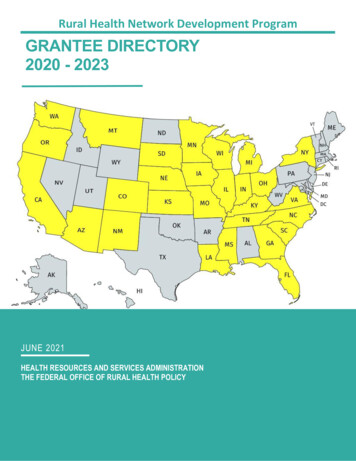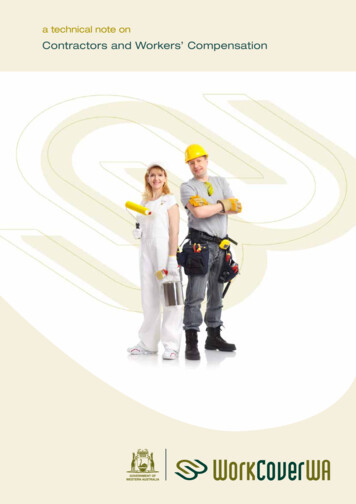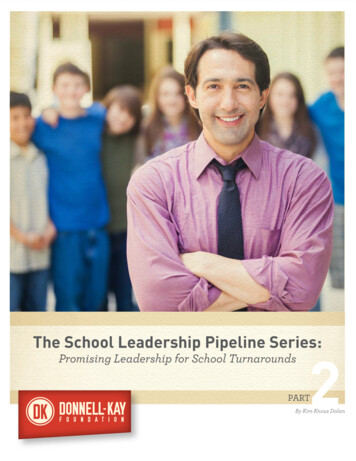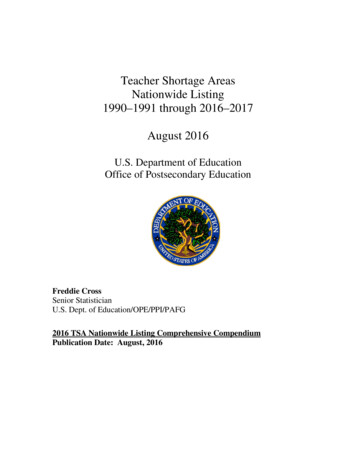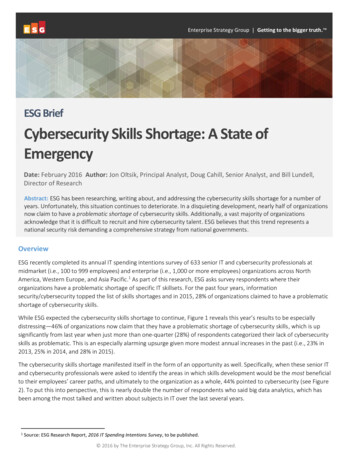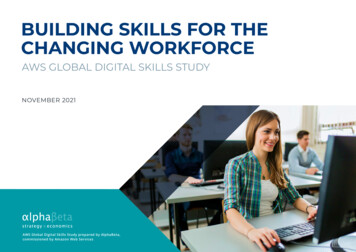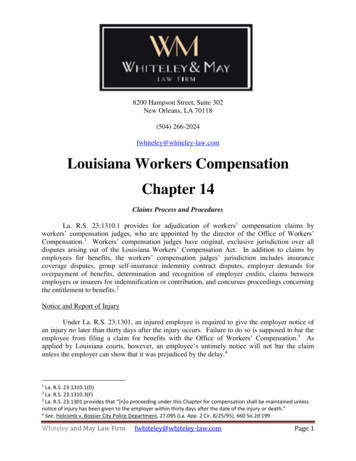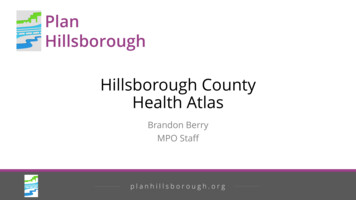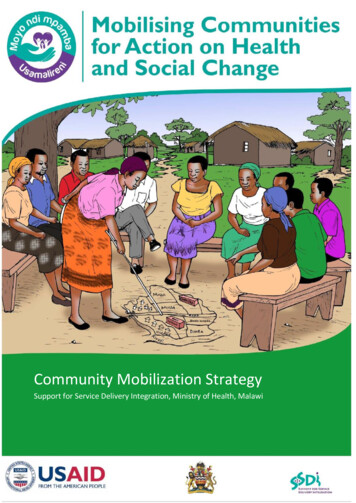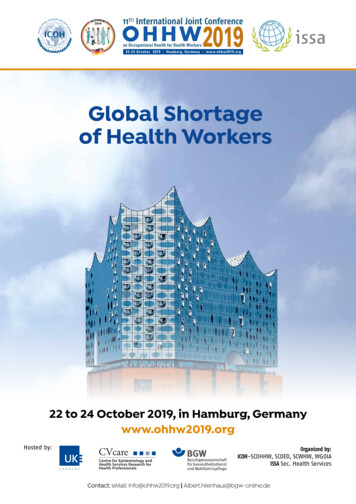
Transcription
11th International Joint ConferenceO H H W 2019on Occupational Health for Health Workersissa22-24 October 2019 l Hamburg, Germany I www.ohhw2019.orgGlobal Shortageof Health Workers22 to 24 October 2019, in Hamburg, Germanywww.ohhw2019.orgHosted by:Organized by:ICOH-SCOHHW, SCOED, SCWHW, WGOIAISSA Sec. Health ServicesContact: eMail: info@ohhw2019.org Albert.Nienhaus@bgw-online.de
Impressum Albert Nienhaus, Hamburg, GermanyProgram of the 11th Joint Conference on Occupational Health for Health Workers,Hamburg October 21st to October 25th 2019Congress organized by the Scientific Committee of Occupational Health for Health Worker (SC OHHW),as part of the activities of the International Committee of Occupational Health (ICOH)Editor of the Program: Albert Nienhaus, Hamburg, GermanyDesign and Graphics: Ethel Ann-Karen Knop, Hamburg, GermanyPhoto: msphotographics, Melbourne, AustraliaPrinted by: Hans Soldan Druck GmbH, Bocholder Straße 259, 45356 EssenLegal Responsibility: Albert Nienhaus, Hamburg, Germany
Table of contentAbout OHHW2019511th Joint Conference on Occupational Health for Health Workers 2019SC OHHW Conference History6Welcome Notes7Global Shortage of Health Workers9Mission Statement of the Scientific Committee on OccupationalHealth for Health care Workers (SC OHHW)9Mission of the Scientific Committee Women, Health & Work10Mission of the Scientific Committee on Occupational andEnvironmental Dermatoses11Mission of the International Section of the ISSA on Preventionof Occupational Risks in Health Services12Conference Program13Keynote Speakers19Program Overview: Parallel Sessions 1/2/342Wednesday, October 23rdAbstracts of Parallel SessionsProgram Overview: Parallel Sessions 1/2/3Thursday, October 24thAbstracts of Parallel SessionsList of Posters46747795Presenters and Poster TitelsParticipants96100OHHW2019
About OHHW201911th Joint Conference on OccupationalHealth for Health Workers 2019The main conference topic is the global shortage of health workers. Differentaspects are presented and discussed by more than 160 Occupational HealthExperts from 41 different countries in the light of this main topic. In addition, the congress focus on themes such as war, economic crisis, migration, and other critical circumstances that have a strong impacton health worker‘s health.The conference is organized by the Scientific Committee of Occupational Health for Health Worker (SCOHHW), with the support of further Scientific Committees of ICOH (Women Health and Work (SC WHW)and Occupational and Environmental Dermatosis (SC OED), the WGOIA (Working Group of OccupationalInfectious Agents of ICOH) and ISSA (International Social Security Association, Section Healthcare andWelfare). This conference is supported by the BGW (Berufsgenossenschaft für Gesundheitsdienst undWohlfahrtspflege, (Institution for Statutory Accident Insurance and Prevention in the Health and WelfareServices).The conference is endorsed by: International Labour Organization (ILO), Switzerland European Agency of Safety and Health at Work, Spain Institut National de Recherche et de Sécurité (INRS), FranceFrom the Medical Association the OHHW2019 was granted 45 points for Continued Medical Education(CME). Seven CME points for the workshop HEALTHwise on Monday, Oct 21st, 31 CME points for the mainconference on Tuesday, Wednesday and Thursday, October 22nd to October 24th, and 7 CME points forthe workshop on violence prevention on Friday, Oct. 25th 2019.The OHHW2019 conference is part of the activities of ICOH.The International Commission on Occupational Health (ICOH) is an international non-governmental professional society whose aims are to foster the scientific progress, knowledge and development of occupational health and safety in all its aspects. It was founded in 1906 in Milan as the Permanent Commissionon Occupational Health. Today, ICOH is the world‘s leading international scientific society in the field ofoccupational health with a membership of 2,000 professionals from 105 countries. The most visible activities of ICOH are the triennial World Congresses on Occupational Health, which are usually attended bysome 3,000 participants. The 2021 Congress will be in Melbourne (Australia) and the ICOH 2024 Congressin Marrakesh (Morocco). ICOH has 37 Scientific Committees. Most of these committees have regular symposia, scientific monographs and review the abstracts submitted to the International Congresses.For more information on ICOH and on how to become amember of ICOH, please visit the website: www.icohweb.org5OHHW2019
SC OHHW conference historyNo. in seriesYearDateCityCountry1st meeting1989-RouenFrance2nd meeting1990-MontrealCanada3rd urghScotland5th1999-MontrealCanada6th20048 – 10 OctoberKitakyushuJapan7th200725 – 28 OctoberVancouverCanada8th201027 – 31 OctoberCasablancaMorocco9th201323 – 26 SeptemberSao PauloBrazil10th201728 – 30 NovemberKhon KaenThailand11th201922 – 24 OctoberHamburgGermany6OHHW2019
W ELCO M E NO T EWelcome Note from the Chair and Secretary ofthe Scientific Committee of Occupational Healthfor Health WorkersWe are excited to welcome you to the 11th International Joint Conference on Occupational Health forHealth Workers. We have been working diligently for the past two years to prepare a program featuringsome of the important emerging global issues confronting all of us in these times of environmental,economic and political challenges within the context of the global shortage of health care workers andinadequate access to healthcare.This conference is a joint effort between the Scientific Committees of ICOH (Occupational Health for HealthWorkers, Women Health and Work), the WGOIA (Working Group of Infectious Agents of ICOH) and ISSA(International Social Security Association). This conference could not have been accomplished withoutthe support of BGW (Berufsgenossenschaft für Gesundheitsdienst und Wohlfahrtspflege, (Institution forStatutory Accident Insurance and Prevention in the Health and Welfare Services).The conference features keynote talks and panels presented by experts from around the world, presentations of abstracts submitted from six continents and pre- and post-conference workshops – one on the useof HealthWISE and the other on Violence in Health Care Settings.We hope this conference will be informative, stimulating and create opportunities to network with colleagues from all over the world thus enhancing your abilities for continued improvement in your healthcare systems.Gwen Brachman, US, Chair of the SC OHHWAntoon De Schryver, Belgium, Secretary of the SC OHHW7OHHW2019
W ELCO M E NO T EWelcome Note from the Host of the OHHW2019For the 11th International Joint Conference Occupational Health for Health Workers we chose an urgentbut ambitious topic:Occupational Health for Health Workers in Timesof Global Shortage of Health WorkersWorldwide about 1/3 of the population is affected by migration. Health Workers (HW) are part of this migration population and HW try to meet the special needs of the migrants. Out of this situation, differentproblems concerning Occupational Health of HW arises. On the OHHW2019 conference, experts from around the world will discuss these different aspects. I amparticularly proud that we were able to invite experts from Africa and South Americato give testimonials about occupational health for health workers in crises. Enrichedare these contributions by interventions of experts from North America, Asia andEurope.In addition to the main topic a wide range of aspects are covered: infections andvaccination, pregnancy and work in healthcare, violence against HW, psycho-socialexposure of HW and ergonomics. We had the privilege to compile a program outof more than 100 abstracts submitted to our website. Unfortunately, it was notpossible to grant an oral presentation to all interesting and qualified submissions. Those who might bedisappointed with being nominated for a poster presentation ‘only’, I want to reassure that the posters willbe displaced at a very central location of the conference venue.During the process of composing the program, many colleagues were engaged and supportive. I wantto thank them all. My particular thanks go to Gwen Brachman, US, Anton De Schryver, Belgium, AcranSalmen-Navarro, US, Igor Bello, Venezuela, Fouad M. Fouad, Lebanon, Ehi Iden, Nigeria, and Mary Ross,South Africa, for their valuable contributions to composing the program.In the wake of the conference, we had many email exchanges with a lot of empathy and encouragement.Now we are looking forward to get to know you in person. We hope that you will have a safe and enrichingstay in Hamburg with a lot of interesting presentations and exchanges between colleagues and expertsfrom around the world. We wish you many good memories as well as a lot of new or refreshed contacts tocarry home after the OHHW2019.Albert Nienhaus and the OHHW2019 Preparation Team in Hamburg8OHHW2019
Global Shortage of Health WorkersGlobal Shortage of Health WorkersMission Statement of the Scientific Committeeon Occupational Health for Health care Workers(SC OHHW)Gwen Brachman, Chair of the SC OHHWHealth workers comprise the largest global workforce and are found in every country.The health care workforce includes individuals who provide health services – doctors,nurses, midwives, dentists, emergency medical responders, medical, nursing and dental assistants, therapists, laboratory technicians, social workers and pharmacists alongwith students training in these areas. The health workforce also includes those individuals whoprovide management and supportive services – administrators, financial officers, clerical personnel, cooks,transport (both within-facility and drivers), security, housekeeping and facilities operations (plumbers,electricians, painters, carpenters). Worldwide, there are 59.8 million health workers. About two-thirdsof them (39.5 million) provide health services; the other one-third (19.8 million) are management andsupport workers. Women comprise nearly 80% of the health care work force (WHO).Women comprise nearly 80% of the healthcare work forceHealth care is the fastest-growing industry in many developed countries. At the same time, there is aglobal shortaqe of health care personnel, which has reached a crisis level in 57 countries, most of themin Africa, Asia and the Mid-East. Currently there is a shortage of 7.2 million health care workers; thisshortage is expected to increase to 12.9 million by 2035. (WHO, 2006) Although there are several factorsleading to the shortage of health care workers, a major contributor is unsafe working conditions leading towork-related illness and injury with significant morbidity and mortality (particularly from infectious diseases including HIV, Hepatitis B and C, Tuberculosis and Ebola). The fear of contracting one of these illnessesleads to further attrition and to a decreased number of individuals entering the health care professions.The shortage of health care workers puts increased work demands and stress on the remaining health careworkforce, which, in turn, further increases unsafe working conditions. Protecting the health and safetyof health care workers is essential in order to have an adequate workforce of trained and healthy healthcare personnel.Health care workers are exposed to a variety of health and safety hazardsA health care facility is a workplace as well as a place for receiving and giving care. Cases of occupationalinjury and illness among health care workers are among the highest of any industry sector. Health careworkers are exposed to a complex variety of health and safety hazards on a daily basis including: biologicalhazards (such as TB, Hepatitis, HIV/AIDS, SARS, Ebola); chemical hazards (such as, glutaraldehyde, ethylene9OHHW2019
Global Shortage of Health Workersoxide, latex); physical hazards (such as noise, radiation, slips, trips and falls); ergonomic hazards (such asheavy lifting, repetitive motion at awkward angles); psychosocial hazards (such as shiftwork, violence andstress); fire and explosion hazards (such as using oxygen, alcohol sanitizing gels).No effective health care system without a healthy workforceBecause their jobs are to care for patients, the hazards and risks that health care workers face every day areoften ignored or relegated to a low priority. In fact, health care workers are “expected” to accept the risksentailed in performing their jobs, often sacrificing their own health and safety for that of their patients.Fortuitously, the measures that protect health care workers from injury and illness also serve to protectpatients’ health and safety. Health care workers need to be protected from workplace hazards; there canbe no effective health care system without a healthy workforce.The aims of the Scientific Committee on Occupational Health forHealthcare Workers (SC OHHW) are: Foster the scientific progress, knowledge and development of occupational health andsafety in health care settings Provide forums for discussion of current health and safety issues affecting health careworkers and health care settings Foster and participate in international dialogues and provide input for guidance regardinghealth and safety issues for health care workers Create guidelines, tools and training opportunities and make these available to ICOHmembers and other interested persons and institutions Foster cooperative relationships with WHO, ILO and other international and NGOorganizations in pursuing the above stated goalsThe Scientific Committee on Occupational Health for Healthcare Workers (SC OHHW) is the main organizerof the OHHW2019.Mission of the Scientific Committee Women,Health & WorkWomen’s participation in the world of work is constantly increasing all around the world. Women assumeimportant roles and increasingly are coming in work sectors that use to be exclusive destined for men.Also, gender parity seems to be improving. These are part of the good picture. However, employment andwork inequities persist, despite the fact that women’s work and importance is widely recognized.Data from The Global Gender Gap Report – that assesses the 134 countries on how well they are dividingtheir recourses and opportunities among their male and female populations –, examines the gap betweenwomen and men in four fundamental categories: economic participation and opportunity; educational10OHHW2019
Global Shortage of Health Workersattainment; political empowerment; and health and survival. The 2014 Report states that there are manypositive gains in the overall index scores, indicating that the world in general has made progress towardsequality between women and men, although there are countries that continue to lose ground. This versionshows that the economic participation gap has increasingly closed from 56% to 60% between 2006 and2014. As well, the educational attainment gap closure increased from 92% in 2006 to 94% in 2014.However, the situation is worrisome for health and survival, since it shows a small deterioration from 97%in 2006 to 96% in 2014. And although the global political empowerment gap closed at 14% in 2006,and increased to 21% in 2014, still is very low. The Nordic countries have held the highest positions inall editions of the Report.The comparison between the countries can be seen as controversial and raises questions. The Index doesnot feature women’s empowerment in each country; its aim is to focus on whether the gap between womenand men in the chosen variables has declined. Even though there are questions about the index, the factthat it includes the ‘health and survival’ category as one of its fundamental categories is important for allof us working in this area. Professor Kaisa Kauppenin, former Chair of our SC, explained that this categorycould be further elaborated to be more precise, in the same way that the other categories. The healthand survival category has only two variables: The first is the gap between women’s and men’s healthy lifeexpectancy, and the second is the sex ratio at birth, which in fact is fundamental in regards to women’sand men’s health, but other variables of workers’ health could be more detailed. We wish is that the ICOHSC WHW members could strongly participate in this global discussion on women’s health and well-beingand bring a work-related perspective into it. We will appreciate your input and comments in this importantglobal issue!This text is from the website of the SC: http://www.icoh-scwhw.net/home/We are thankful for the support of the Chair Dr. Marcia Bandini, São Paulo, Brasil, and the Secretary Prof.Igor Jesus Bello Sociedad Venezolana de Salud Ocupacional, Valencia, Venezuela, of the SC for the preparation of the conference. Marica Bandini and Igor Bello will give several interventions at the OHHW2019.Mission of the Scientific Committee onOccupational and Environmental DermatosesICOH s SC on occupational and environmental dermatoses (SC OED) aims at raising awareness of thechallenges of the huge spectrum of these diseases (from irritant and allergic contact dermatitis to skincancer), their pathogeneses and the effectiveness of preventive measures to the workers health benefit.It wants to foster exchange on new research findings pertaining to occupational dermatoses, which are inmany countries the most frequent occupational illnesses. The SC actively supports the current initiative ofWHO and ILO as to the assessment of the global disease burden of some disease entities within its scope.We are thankful for the support of the Chair Dr. Sanja Kezic, Coronel Institute of Occupational Health,Amsterdam, The Netherlands and the Secretary Prof. Swen Malte John, University of Osnabrück Germany,for the preparation of the conference. Sven M. John will give a talk on occupational and environmentaldermatoses and the mission of the SC on Wednesday morning Oct 23rd during the plenary session.11OHHW2019
Global Shortage of Health WorkersMission of the International Section of the ISSAon Prevention of Occupational Risks in HealthServicesThe International Social Security Association (ISSA) is the world’s leading international organization forsocial security institutions, government departments and agencies. The ISSA promotes excellence in socialsecurity administration through professional guidelines, expert knowledge, services and support to enableits members to develop dynamic social security systems and policy throughout the world.The ISSA was founded in 1927 under the auspices of the International Labour Organization, and today hasover 320 member institutions from over 150 countries. The ISSA is organized in different InternationalSections.The International Section of the ISSA on Prevention of Occupational Risksin Health Services aims to improve occupational safety in health servicesthrough the international exchange of experience. Occupational risksin the health services sector differ widely from those in other fields ofwork. These risks are quite similar in different countries, but the measures taken to cope with them vary from country to country.The International Section of the ISSA on Prevention of Occupational Risks in Health Services aims todetermine and to compare the state of occupational safety in health services in various countries, and todevelop recommendations on how to apply proven or new methods on a worldwide basis. The Section aimsto promote safety and health for health-care workers, the prevention of work accidents and the preventionof occupational and work-related diseases in health services.In many countries experience in occupational safety in health services is available. By enabling discussionbetween medical and technical experts from the safety field, and with the authorities and social securityinstitutions, the health-care facilities and their employees, it is possible to better protect the health andsafety of people working in health care services. The Section seeks to promote the pooling, assessment,improvement and dissemination of knowledge. Through the exchange of experience, existing methods canbe enhanced and new solutions for areas showing deficits can be developed.The Section identifies and promotes effective methods for enhancing occupational safety for the differentprofessions in health care, through conferences, colloquia and seminars, and raises awareness of risksthrough the international exchange of information.The main focus of activity is on occupational and work-related diseases. The findings, experiences andproposals collected by the Section are presented to the public, in particular to the specialist public, asprinted material or in meetings.The Secretariat of the Section is based in Hamburg, Germany, at the Berufsgenossenschaft für Gesundheitsdienst und Wohlfahrtspflege, BGW, (Institution for statutory accident insurance and prevention inthe health and welfare services), which is entrusted with providing the Secretariat.For more information see: https://ww1.issa.int/prevention-health12OHHW2019
ConferenceProgram6PROPROGRAM15.00–15.30Coffee break, Poster exhibition17.00–18.00Midterm Meeting WGOIA17.00–18.00Poster walk18:30–19:30Come together in the Curio Housewith live music19:30–24:0012.00–12.30Current ansector, inclthe EuropeLorenzo Mun12.30–13.30Lunch ence DinnerThursday, October 24th8.00–8.30Reception, Registration, Coffee,Poster exhibition8.30–9.00Occupational Health as Public Health:an integrated vision.Marcia Bandini, Universidade Estadual de Campinas, BrasilConference Programfrom Monday, October 21thto9.00–9.30Friday,Gender issusesOctoberin the health care sector in25Europe– results from EU-OSHA research.Elke Schneider, EU-OSHA, Switzerland9.30–10.00Pregnancy and immunization in the health sector.Viviana Gómez-Sánchez, Latin American Associationon Occ Health/PAHO, Costa Rica10.00–10.30Coffee break, Poster exhibition10.30–11.00Adaptations of workplaces for pregnant womenin the health sector.Danileing Lozada, Venezuelan Society onOccupational Health, Venezuela11.00–12.30Occupational Nursing in the XXI century.Astrid Garrido, Ludwig Maximillian University (LMU),Munich, Germany11.30–12.00Risk management in Health Centers:a gender approach.Igor Bello, Venezuelan Society on OccupationalHealth, VenezuelaFlyer Programm OHHW 7.10.2019 printversion.indd 113OHHW2019ParallelstSee flyer: P15.30–16.00Coffee bre16.00–16.45Closing sesFriday, Oc9.00–15.00Workshop PEllen DelvauKai Hochsch
Scientific CommitteeWorkers (SC OHHW),tional and Environientific CommitteeHW) of the Interntiolth (ICOH) and thetional Social SecurityOccupational RisksConference Program3PROGRAMMonday, October 21st10.00–16.0013.30–14.00Introductioconcepts, inAcran Salme14.00–14.30Doctors witfor health wCarlos José CHospital Car14.30–15.00DANGER! Hrefugees, impersons, anMason D. Ha15.00–15.30Healthcareof VenezueIgor Bello, VeOccupationa15.30–16.00Coffee bre16.00–16.30Displaced hcrisis situatEhi Iden, CEOManagers, La16.30–17.00Women heasettings.Rima Habib,University of17.00–17.30Working cocountries –Abdeljalil ElMorocco17.30–18.00The Ebola Eand receiviStefan SchmHamburg, Ge18.00–19.00Come toge20.00–22.00Evening pBoat tourTuesday, October 22nd8.00–9.009.00–9.30orkers in Timeskerstion is affected bye part of this migrat the special needsn, different problemsHW arises. On theom around the worldIn addition a widens and vaccination,violence against HW,ergonomics.Workshop HealthWISE –Work Improvement in Health Services.Simphiwe Mabhele, International Labour Organization,South Africa,Elizabeth Wilcox, University of British Columbia, Canada,Muzimkhulu Zungu, National Institute for OccupationalHealth, South AfricaPRO9.30–10.1510.15–11.00Reception, RegistrationWelcome messages, opening of the conference.Gwen Brachman, SC OHHW,Igor Bello, SC WHWVolker Harth, German ICOH group,Stefan Brandenburg, CEO BGW, ISSA HW,Albert Nienhaus, President of the conferenceGlobal shortage of health workers and theconsequences for OSH.Christiane Wiskow, ILO, Geneva, SwitzerlandHealth systems without borders, re-thinking healthsystem frameworks in times of forced migration.Fouad M. Fouad, American University of Beirut, Lebanon11.00–11.15Coffee break, Poster exhibition11.15–11.45Working conditions in a healthcare system incrisis – the case of Zimbabwe.Tawanda Nherera, BOC Zimbabwe (Pty) Ltd, Harare,Zimbabwe11.45–12.15HWs and informal health services in middle-east.Fouad M. Fouad, American University of Beirut, Lebanon12.15–12.30Q A with all presenters of the morning12.30–13.30Lunch break13.30–17.30DISPLACED PERSONS – providing health care todisplaced persons and displaced health workers.14OHHW2019
Conference ProgramAMPROGRAM13.30–14.00alth Services.onal Labour Organization,14.00–14.30f British Columbia, Canada,Institute for Occupational14.30–15.00Introduction – history of migration and generalconcepts, interventions for immigrant HWs in NYCAcran Salmen-Navarro, NYU School of Medicine, USADoctors without borders. Occupational risk factorsfor health workers in a humanitarian crisis?Carlos José Chavera Bianchi, Argentina,Hospital Carlos Bonorino UdaondoDANGER! Health workers at risk. Working withrefugees, immigrants, migrants, displacedpersons, and persons in areas of conflict.Mason D. Harrell, FACOEM, USAPRWedne8.00–9.00ReceptiPoster 0VisionprevenMarija B10.00–10.30OccupaPrevenSven Ma10.30–11.00Coffee11.00–11.30New deof shorWilliam11.30–11.45Zero TBUN DecGwen Br11.45–12.15ProtectWe neeRodney E12.15–12.30Q A w12.30–13.30Lunching of the conference.15.00–15.30Healthcare in crisis situations – the exampleof Venezuela.Igor Bello, Venezuela, Venezuelan Society onOccupational Health, Chair SC WHW15.30–16.00Coffee break, Poster exhibition16.00–16.30Displaced health workers and healthcare incrisis situations from an African perspective.Ehi Iden, CEO, Occupational Health and SafetyManagers, Lagos, Nigeriagroup,W, ISSA HW,the conferenceworkers and theva, Switzerlandorders, re-thinking healthes of forced migration.niversity of Beirut, Lebanon16.30–17.00xhibitionhealthcare system inbwe.abwe (Pty) Ltd, Harare,services in middle-east.niversity of Beirut, Lebanon17.00–17.3017.30–18.00of the morningoviding health care toplaced health workers.Women health and health care in conflictsettings: a gender perspective.Rima R. Habib, Beirut, Lebanon, AmericanUniversity of BeirutWorking conditions of HCW in developingcountries – a North African Perspective.Abdeljalil El Kholti, Hassan II University of Casablanca,MoroccoThe Ebola Experience – Sending HW to endemicsand receiving infectious patients from abroad.Stefan Schmiedel, Bernhard Nocht InstituteHamburg, Germany18.00–19.00Come together and poster walk20.00–22.00Evening program:Boat tour (Habour and Elbe at night)15OHHW201913.30–17.15PaErCoPsOchuorOcSe
Conference Program5AMmigration and generalor immigrant HWs in NYCSchool of Medicine, USAOccupational risk factorsumanitarian crisis?Argentina,daondoat risk. Working withigrants, displacedareas of conflict.USAPROGRAMWednesday, Oct. 23rd8.00–9.00Reception, Registration, Coffee,Poster exhibition9.00–9.30Achieving a sustainable Health Care Workforcethrough Macroergonomics.Andrew S. Imada, Ph.D. Former President of theInternational Ergonomics Association, USA9.30–10.00Vision zero – how to create a culture ofprevention.Marija Bubas, Croatian Institute of Public Health, Croatia10.00–10.30Occupational skin diseases in HW, Risk factors,Prevention and Rehabilitation Strategies.Sven Malte John, IDerm, University Osnabrück, Germany10.30–11.00Coffee break, Poster exhibition11.00–11.30New delivery systems and telemedicine in timesof shortage of occupational health specialistsWilliam Buchta, Mayo Clinics, USA11.30–11.45Zero TB and Non Communicate Diseases in theUN Declaration – ICOH Efforts.Gwen Brachman, New Jersey, USA, Chair SC OHHWn, American11.45–12.15Protecting HCWs from TB in high risk settings.We need a comprehensive approach.Rodney Ehrlich, University of Cape Town (UCT), South AfricaCW in developingan Perspective.I University of Casablanca,12.15–12.30Q A with all presenters of the morning12.30–13.30Lunch break, SC OHHW business meetingions – the exampleuelan Society onSC WHWxhibitionand healthcare inAfrican perspectiveHealth and Safetyh care in conflictending HW to endemicspatients from abroad.Nocht Instituteer walkElbe at night)13.30–17.15Parallel sessions 1/2/3Ergonomics in Prevention of MusculoskeletalConditions in Health Workers.Psycho-Social Exposure in Health Workers.Occupational Infectious Agents: health andhumanitarian workers and beyond, Sessionorganized and coordinated by Working GroupOccupational Infectious Agents (WGOIA)See flyer: Parallel Sessions16OHHW201908.10.19 07:57
ConferenceProgram6PROPROGRAM15.00–15.30Coffee break, Poster exhibition17.00–18.00Midterm Meeting WGOIA17.00–18.00Poster walk18:30–19:30Come together in the Curio Housewith live music19:30–24:0012.00–12.30Current ansector, inclthe EuropeLorenzo Mun12.30–13.30Lunch ence DinnerThursday, October 24th8.00–8.30Reception, Registration, Coffee,Poster exhibition8.30–9.00Occupational Health as Public Health:an integrated vision.Marcia Bandini, Universidade Estadual de Campinas, Brasil9.00–9.309.30–10.00Gender issuses in the health care sector in Europe– results from EU-OSHA research.Elke Schneider, EU-OSHA, SwitzerlandPregnancy and immunization in the health sector.Viviana Gómez-Sánchez, Latin American Associationon Occ Health/PAHO, Costa Rica10.00–10.30Coffee break, Poster exhibition10.30–11.00Adaptations of workplaces for pregnant womenin the health sector.Danileing Lozada, Venezuelan Society onOccupational Health, Venezuela11.00–12.30Occupational Nursing in the XXI century.Astrid Garrido, Ludwig Maximillian University (LMU),Mu
Salmen-Navarro, US, Igor Bello, Venezuela, Fouad M. Fouad, Lebanon, Ehi Iden, Nigeria, and Mary Ross, South Africa, for their valuable contributions to composing the program. In the wake of the conference, we had many email exchanges with a lot of empathy and encouragement. Now we are looking forward to get to know you in person.
